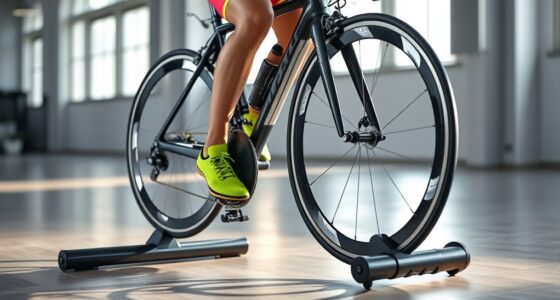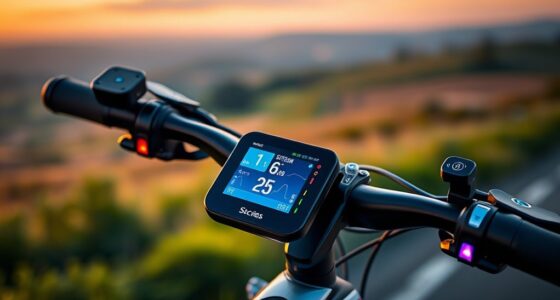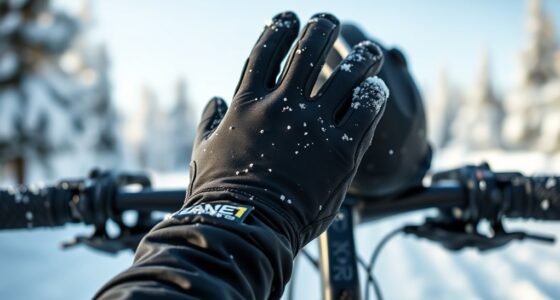If you’re looking to boost your cycling performance in 2025, I recommend checking out the top 15 power meters like the Favero Assioma Duo, Garmin Rally RS100, and Magene P505. These offer precise data, easy connectivity, and durability for both road and MTB riding. Each model provides unique features to match your training style. Keep going, and you’ll discover detailed insights on selecting the best power meter to elevate your ride.
Key Takeaways
- The list features top-rated pedal and crank-based power meters for 2025, highlighting accuracy, durability, and compatibility.
- It includes detailed reviews of models like Favero Assioma, Garmin Rally, and Magene for various cycling needs.
- Pros and cons are provided to help cyclists choose the best power meter based on their riding style and budget.
- Connectivity options such as Bluetooth and ANT+ are emphasized for seamless device integration.
- The guide covers design features, installation ease, and advanced metrics for maximizing ride performance.
Assioma UNO Side Pedal Based Power Meter
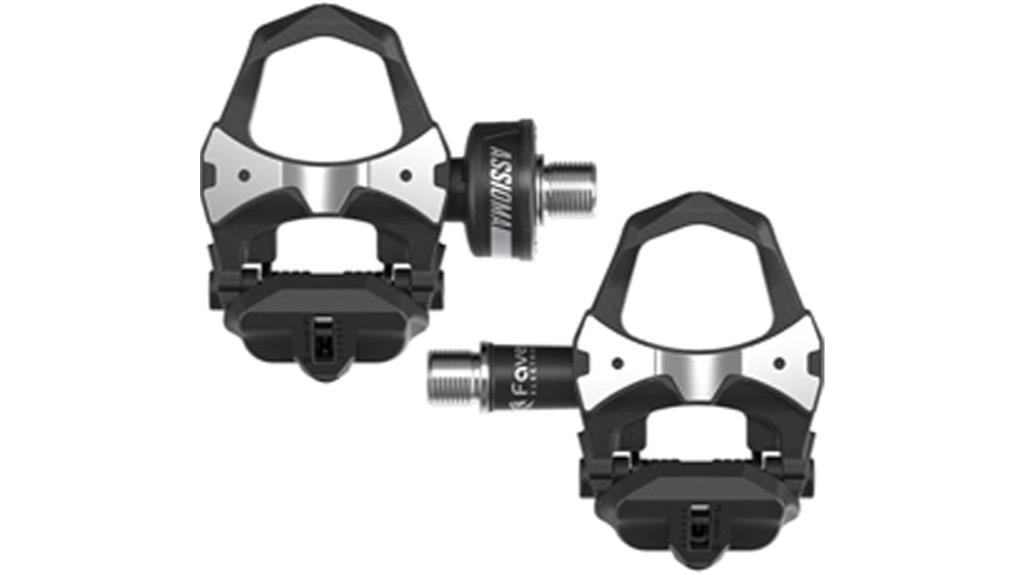
If you’re looking for an accurate and easy-to-install power meter, the Assioma UNO Side Pedal is an excellent choice, especially for road cyclists who want reliable data without complicated setup. I found it straightforward to install, and its rechargeable batteries last over 50 hours, so I don’t worry about frequent charging. The pedals connect seamlessly via Bluetooth and ANT+ to my bike computer and smartphone, providing precise watt measurements. Self-calibration makes sure my data stays accurate, even when switching bikes. Lightweight and stylish, the Assioma UNO is perfect for serious training or casual rides, offering dependable performance without fuss.
Best For: cyclists seeking an accurate, easy-to-install power meter that offers reliable data without complex setup, suitable for both serious training and casual riding.
Pros:
- Easy installation and seamless Bluetooth/ANT+ connectivity
- Rechargeable batteries lasting over 50 hours per charge
- Highly accurate measurements with quick self-calibration
Cons:
- Some users experience pedal spin during clipping and tension adjustment issues
- Build quality of tension screw may be inconsistent for some riders
- Slightly higher price compared to basic pedal options
Magene P505/P515 Power Meter Crankset with 1% Accuracy

The Magene P505/P515 Power Meter Crankset stands out for cyclists seeking reliable, high-precision data at a budget-friendly price. With ±1% accuracy, it uses advanced strain gauges, acceleration sensors, and temperature compensation to deliver consistent readings across different conditions. Made from durable 7075 aluminum and weighing just 625g, it’s built to last through 100,000 pedaling cycles. Compatible with most road bikes via a 24mm spindle and supporting Bluetooth and ANT+, it easily connects to popular devices. Its waterproof rating guarantees all-weather performance, making it a dependable choice for serious training and long-distance rides without breaking the bank.
Best For: cyclists looking for an accurate, durable, and budget-friendly power meter for both indoor and outdoor training.
Pros:
- Offers ±1% high-precision accuracy with advanced sensors and temperature compensation.
- Durable construction from aircraft-grade aluminum, supporting over 100,000 pedaling cycles.
- Easy to install and connect via Bluetooth and ANT+, compatible with most bike computers and apps.
Cons:
- Minimal documentation, which may require watching tutorials for assembly.
- Initial pairing and charging issues reported by some users, needing extra cables or support.
- Regular torque checks and maintenance recommended to ensure long-term reliability.
Favero Assioma PRO MX-1 Cycling Power Meter with Bluetooth & ANT

Favero Assioma PRO MX-1 Cycling Power Meter stands out as an ideal choice for mountain bikers and gravel riders seeking accurate, reliable power data in challenging terrains. Its pedal-based SPD design is compatible with any crank arm, oval or round chainrings, and crank boots, making it versatile. Built with durable aluminum and shock-resistant components, it’s ready for rough trails. The power meter offers ±1% accuracy, detailed metrics like left/right balance, pedal smoothness, and torque effectiveness, and connects seamlessly via Bluetooth and ANT+. With rechargeable batteries lasting over 60 hours, it’s both precise and low-maintenance for all your rides.
Best For: mountain bikers and gravel riders seeking durable, accurate, and versatile power measurement in challenging terrains.
Pros:
- Highly accurate with ±1% precision, providing reliable performance data
- Durable construction with shock-resistant components suitable for rough trails
- Seamless connectivity via Bluetooth and ANT+ with extensive metrics like left/right balance and pedal smoothness
Cons:
- Single-sensing side pedal may not provide complete power balance data
- Requires regular charging, which might be inconvenient for some users
- Compatibility depends on bike computer or smartphone support for Bluetooth/ANT+
Assioma Duo Side Pedal Based Power Meter
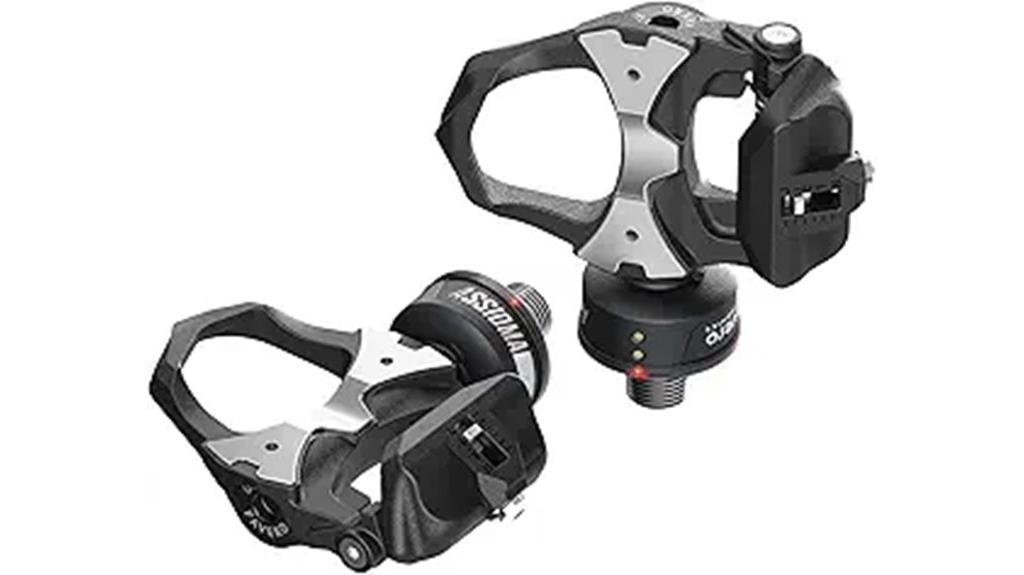
Cyclists seeking precise, reliable power measurement with easy installation will find the Assioma Duo Side Pedal-Based Power Meter an excellent choice. I’ve found these pedals to offer incredibly accurate watt readings, comparable to high-end systems. Setup is quick—calibration takes less than 30 seconds—and switching between bikes is seamless thanks to their lightweight, compact design. With rechargeable batteries lasting over 50 hours, I don’t worry about frequent charging. They connect effortlessly via Bluetooth and ANT+, ensuring smooth communication with my devices. Durable and low-profile, they resist scraping, making them perfect for aggressive riding and long-term use. Overall, they’re an excellent investment for serious cyclists.
Best For: Serious cyclists seeking highly accurate, durable, and easy-to-use power measurement tools for training and performance analysis.
Pros:
- Highly accurate watt readings comparable to high-end power meters
- Easy installation and quick calibration process (less than 30 seconds)
- Long-lasting rechargeable batteries with over 50 hours of use per charge and durable design
Cons:
- Slightly higher cost compared to basic pedal systems
- Some users experience slow email response times from customer support
- Compatibility limited to bikes with 9/16-inch thread standard
Favero Assioma Uno Cycling Power Meter with Cleats and Cleaning Cloth Bundle

If you’re looking for an affordable yet accurate cycling power meter, the Favero Assioma Uno Bundle stands out as an excellent choice. It features a reliable left sensor measuring leg force precisely, with easy installation so you can switch bikes in minutes. The bundle includes two sets of cleats—Red Float (Six Degree) and Black Float (Zero Degree)—plus a cleaning cloth for maintenance. Weighing just 1.43 kg, these resin pedals are compatible with Garmin devices and Zwift, offering detailed data on power, cadence, and balance. Users praise its accuracy, long battery life, and straightforward setup, making it ideal for both casual and serious riders.
Best For: casual and serious cyclists seeking an affordable, accurate, and easy-to-install power meter to enhance training insights and performance.
Pros:
- High accuracy with true left sensor measuring leg force precisely
- Easy installation and quick bike switching without special tools
- Long-lasting rechargeable batteries with up to 50 hours of use
Cons:
- Occasional connectivity issues outdoors affecting data registration
- Slight weight increase (50 grams) compared to traditional pedals
- Requires proper device pairing for optimal performance
Garmin Rally RS100 Single-Sensing Power Meter Pedals
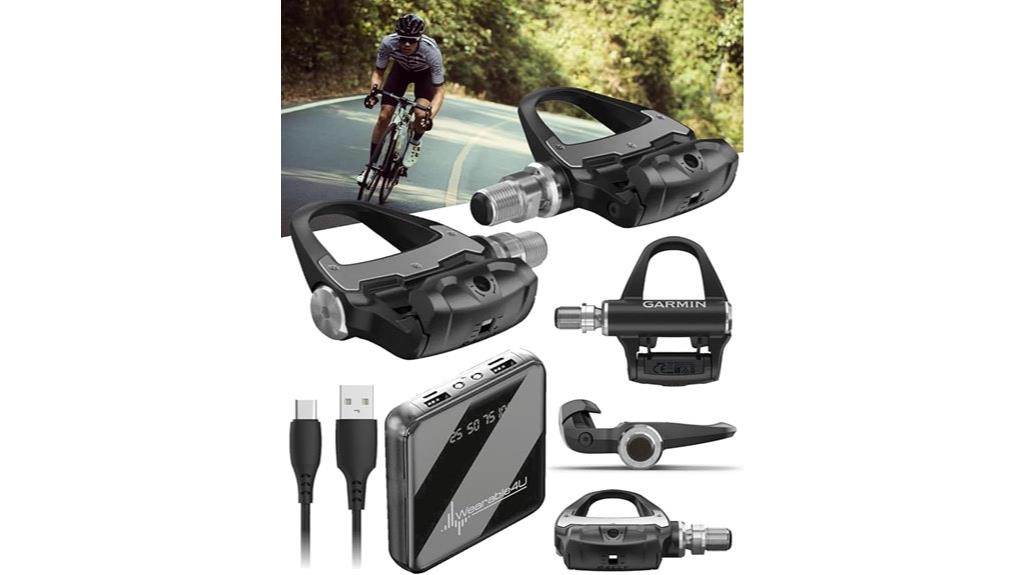
The Garmin Rally RS100 single-sensing power meter pedals are an excellent choice for riders who want reliable, accurate performance data without the complexity of dual-sensing systems. These pedals measure power from the left side and double that for total output, providing essential metrics like power and cadence. Tested in extreme conditions, they’re built for durability and consistent performance. Compatible with Shimano SPD-SL cleats and transferable across road, gravel, and cyclocross bikes, they’re easy to install and switch between bikes. With seamless integration to Garmin devices and upgrade options to dual-sensing, they’re versatile tools that suit a variety of cycling disciplines.
Best For: cyclists seeking a reliable, easy-to-use power meter pedal system that offers accurate performance data and seamless compatibility across different bike types.
Pros:
- Accurate single-sensing power and cadence measurement with easy upgradeability to dual-sensing
- Durable construction tested in extreme conditions, ensuring consistent performance
- Compatible with Shimano SPD-SL cleats and transferable across road, gravel, and cyclocross bikes
Cons:
- Only measures power from the left pedal unless upgraded to dual-sensing
- Slightly heavier at approximately 330 grams per pedal, which may affect weight-conscious riders
- Limited to Garmin-compatible devices for full feature integration without third-party app support
Wearable4U Favero Assioma Duo Pedal Cycling Power Meter Bundle

For those seeking precise and versatile power measurement, the Wearable4U Favero Assioma Duo Pedal Cycling Power Meter Bundle stands out as an excellent choice. I appreciate how these pedals offer accurate left/right power data, with sensors embedded in each pedal. The bundle includes everything I need—pedals, cleats, and a cleaning cloth—making setup straightforward. They’re compatible with many cycling computers via ANT+ and BLE, and the rechargeable batteries last up to 50 hours. Easy to transfer between bikes, they deliver reliable, detailed metrics like cadence, torque, and pedal smoothness, helping me refine my technique for both training and racing.
Best For: cyclists seeking accurate, versatile, and easy-to-use power meters for training and racing across different bike types.
Pros:
- Provides precise left/right power, cadence, torque, and pedal smoothness data within 1% accuracy
- Easy to install, transfer between bikes, and compatible with various cycling computers via ANT+ and BLE
- Rechargeable batteries last up to 50 hours, reducing the need for frequent replacements
Cons:
- Some users have experienced issues with app data transmission despite hardware performance
- Slight differences in pedal weight compared to Shimano may require adjustment for some riders
- Support response times may vary, impacting troubleshooting and customer satisfaction
Favero Assioma Pro MX Power Meter Pedals with Accessories

Favero Assioma Pro MX Power Meter Pedals with Accessories stand out as an ideal choice for mountain bikers and gravel riders seeking durability and precise power data. Made from lightweight aluminum and built to withstand shocks and impacts, they’re highly durable across rugged terrains. Fully SPD compatible, they include MTB-specific cleats and work with Bluetooth and ANT+ devices, ensuring seamless connectivity with various bike computers and apps. Easy to install and swap between bikes, they deliver accurate metrics for both casual and serious riders. The extensive package, including extra cleats, charging tools, and accessories, makes them a versatile, reliable option for off-road cycling.
Best For: mountain bikers and gravel riders who need durable, accurate, and versatile power meters for off-road and rugged terrain cycling.
Pros:
- Highly durable construction with lightweight aluminum and impact resistance suitable for rough terrains
- Fully compatible with Bluetooth and ANT+ devices, ensuring seamless connectivity with various bike computers and apps
- Easy to install, swap between bikes, and includes comprehensive accessories for enhanced convenience
Cons:
- Slightly heavier compared to some other power meters, which may be a concern for weight-sensitive riders
- Single-sided sensor option may limit the depth of power data for some users
- Premium price point might be a barrier for beginner or casual cyclists
Favero Assioma PRO RS Power Meter Pedals with Wearable4U Bundle

If you’re seeking a lightweight and highly accurate power meter pedal system, the Favero Assioma PRO RS with the Wearable4U Bundle is an excellent choice. These pedals, compatible with Shimano SPD-SL cleats, feature sensors on both sides for precise ±1% power measurement, even with oval chainrings. Weighing only 123.5 grams per pedal, they’re incredibly light, and their carbon-fibre body ensures durability. The modular design allows customization, and with over 60 hours of battery life, they support long rides. The bundle includes cleats, accessories, and a wearable4U towel, making it a thorough, reliable option for serious cyclists.
Best For: Serious cyclists seeking lightweight, highly accurate power measurement pedals with long battery life and customizable options for training and long-distance riding.
Pros:
- Extremely lightweight at only 123.5 grams per pedal, reducing rider fatigue
- Precise ±1% power accuracy, even with oval chainrings, ensuring reliable data
- Long-lasting rechargeable batteries with over 60 hours of use per charge, ideal for extended rides
Cons:
- Higher price point compared to basic pedal models, which may be a consideration for budget-conscious users
- Compatibility limited to Shimano SPD-SL cleats, requiring additional footwear adjustments
- Modular design and extra accessories might require some assembly and maintenance for optimal performance
Garmin Edge 530 GPS Cycling Computer
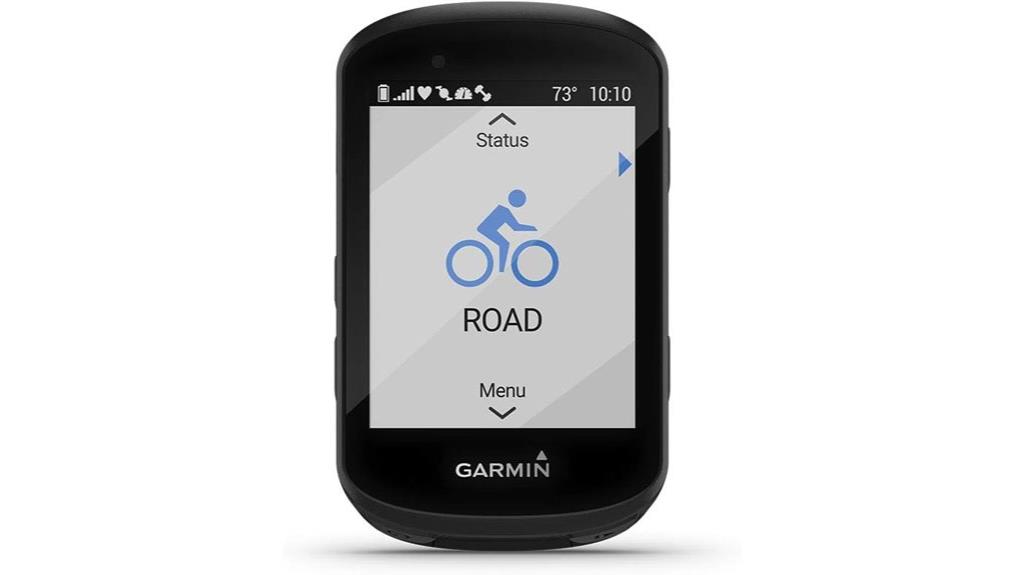
Looking for a cycling computer that combines advanced navigation with extensive performance metrics? The Garmin Edge 530 is perfect. It offers mapping, routing, and performance insights like VO2 max, recovery, and MTB dynamics. Compatible with Vector power meters and ANT Plus sensors, it connects seamlessly via Bluetooth and Wi-Fi. With a compact design, long battery life—up to 20 hours—and customizable features through Connect IQ, it suits all riders. Its rugged build and safety features, like group messaging and assistance, make it reliable on any ride. While setup takes a few minutes, the device’s extensive capabilities profoundly elevate your cycling experience.
Best For: cyclists seeking a feature-rich GPS cycling computer with advanced navigation, performance metrics, and customization options suitable for all riding styles.
Pros:
- Comprehensive performance insights including VO2 max, recovery, and MTB dynamics
- Long battery life up to 20 hours, extendable with Garmin Charge power pack
- Seamless connectivity via Bluetooth and Wi-Fi, compatible with various sensors and accessories
Cons:
- Slightly complex initial setup and learning curve for new users
- No touchscreen; relies on side and bottom buttons which may take time to get used to
- Some users find the device’s extensive features overwhelming without prior familiarity
Favero ASSIOMA PRO MX Series Power Meter Pedals with Power Bank Bundle

Designed for serious cyclists who demand accurate and durable power measurement, the ASSIOMA PRO MX Series Pedals with Power Bank Bundle stand out as a top choice in 2025. These pedals feature advanced IAV Power Technology, delivering ±1% accuracy and real-time L/R balance data. Built with rugged aluminum 6061-T6, they’re resistant to impacts, mud, and water, making them perfect for gravel, trail, or road riding. The bundle includes a power bank for quick charging, MTB-compatible SPD cleats, and all necessary tools. Easy to install and compatible with most devices via Bluetooth and ANT+, these pedals combine precision, durability, and convenience for serious training.
Best For: serious cyclists and triathletes who require highly accurate, durable, and reliable power measurement on gravel, trail, or road riding.
Pros:
- ±1% measurement accuracy with real-time L/R balance data for precise training insights
- Rugged construction with aluminum 6061-T6 and high surface hardness for durability in harsh conditions
- Easy to install and compatible with most devices via Bluetooth and ANT+
Cons:
- May require compatible bike computers or watches for dual-sided power data collection
- Some users reported issues with the charging port’s placement and protective needs
- Setup and pairing can be complex for less tech-savvy users, potentially leading to initial configuration challenges
Magene P715 Power Meter Pedals with ANT+ & Bluetooth

The Magene P715 Power Meter Pedals stand out as an ideal choice for serious cyclists who prioritize accuracy and versatile connectivity. They deliver ±1% power precision, making effort tracking reliable during both outdoor rides and indoor training. Weighing just 157 grams per pedal and built from durable aluminum, they support KEO cleats and dual size compatibility. With Bluetooth and ANT+ dual protocols, pairing is seamless across devices. The long-lasting 120-hour battery ensures extended sessions without frequent charging. Easy to install in about a minute, these pedals are waterproof (IPX7 rated) and come with a thorough package, including two pedals and a warranty, highlighting their quality and durability.
Best For: Serious cyclists and indoor trainers seeking highly accurate power measurement and seamless device connectivity for comprehensive training.
Pros:
- ±1% precise power measurement for reliable effort tracking
- Supports both Bluetooth and ANT+ protocols for versatile device pairing
- Long-lasting 120-hour battery life for extended training sessions
Cons:
- Installation takes approximately 1 minute, which might be slightly longer for some users unfamiliar with bike pedals
- Limited to KEO cleats, potentially requiring additional cleat purchases for compatibility
- Higher price point compared to basic pedal options, which may be a consideration for budget-conscious cyclists
4iiii Precision 3+ Powermeter for Cycling

Cyclists seeking a lightweight, highly accurate power meter that easily integrates with their existing setup will appreciate the 4iiii Precision 3+ Powermeter. Weighing just 9 grams, it offers +/-1% precision with three strain gauges, ensuring reliable data during intense rides. Compatible with Shimano 105 and Hollowtech II cranksets, it’s simple to install and pairs quickly with Garmin devices, smartphones, and Apple Find My. Built tough with waterproofing and durable materials, it withstands harsh conditions. With up to 800 hours of battery life and straightforward calibration, the Precision 3+ delivers real-time insights to optimize your training and performance.
Best For: cyclists seeking a lightweight, highly accurate, and easy-to-integrate power meter for training and competitive cycling.
Pros:
- Extremely lightweight at just 9 grams, minimizing impact on performance
- High accuracy with +/-1% precision and three strain gauges for reliable data
- Durable, waterproof construction suitable for harsh riding conditions
Cons:
- Battery compartment design can be difficult to access and replace the CR2032 battery
- Activation of Apple Find My feature may be cumbersome and inconvenient for some users
- Customer ratings are mixed, with some expressing frustration over setup and battery access issues
Garmin Rally RK200 Dual-Sensing Power Meter Pedals

If you’re serious about optimizing your cycling performance, the Garmin Rally RK200 Dual-Sensing Power Meter Pedals offer precise and all-encompassing data to elevate your training. These pedals provide advanced metrics like total power, cadence, pedal stroke efficiency, and left/right balance, helping you perfect your technique. Compatible with LOOK KEO cleats, they’re easy to install and switch between bikes. With a lightweight design and up to 120 hours of runtime, they’re perfect for long rides and intense sessions. Seamlessly pair with Garmin devices and popular apps like Strava or TrainingPeaks to track progress and push your limits.
Best For: serious cyclists and athletes seeking precise power measurement and advanced training metrics to optimize performance.
Pros:
- Provides comprehensive cycling dynamics including left/right balance and pedal stroke efficiency
- Compatible with LOOK KEO cleats and easy to transfer between bikes
- Long battery life of up to 120 hours supports extended rides and intense training sessions
Cons:
- May be more expensive compared to basic power meters
- Installation requires compatible cleats and proper setup for accurate data
- Heavier than some ultra-lightweight pedal options, which could affect performance for competitive cyclists
SRAM Apex AXS Wide Left Crank Arm and Power Meter Spindle Assembly
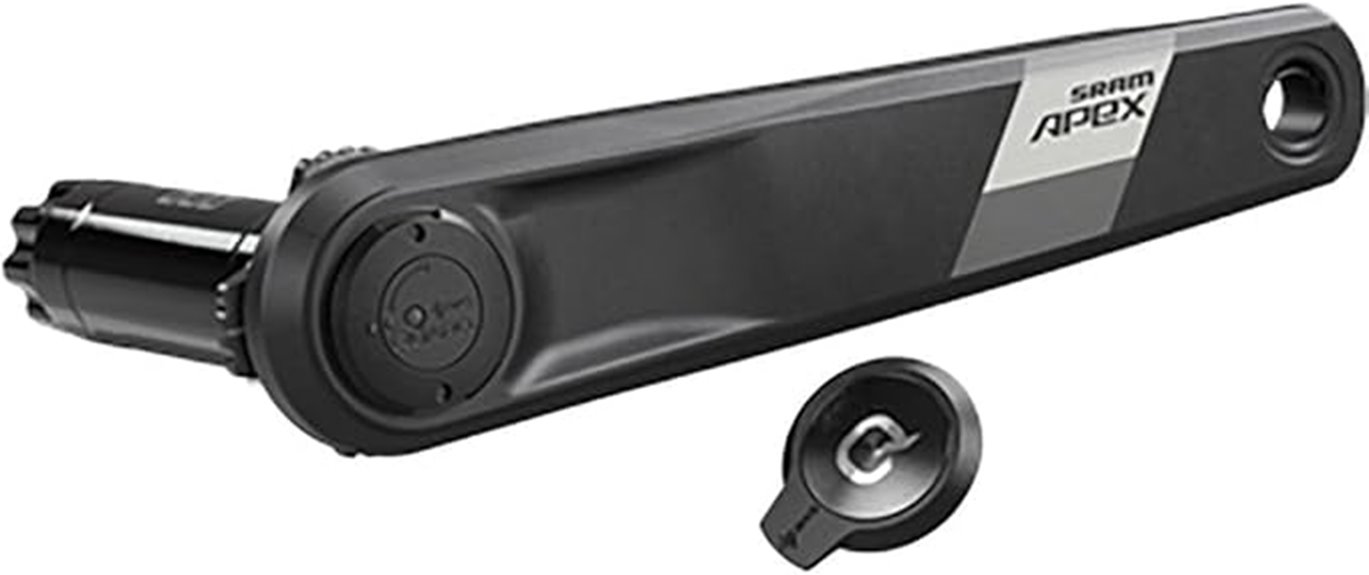
Those seeking a reliable, lightweight power meter for road cycling will find the SRAM Apex AXS Wide Left Crank Arm and Power Meter Spindle Assembly an excellent choice, especially for riders who prioritize accuracy and durability. Designed for 12-speed setups with a DUB spindle interface, it offers precise wattage readings with +/- 1.5% accuracy using proven Quarq technology. With over 400 hours of battery life and an IPX7 waterproof rating, it withstands tough weather conditions. This left-side power meter is compatible with SRAM Road WIDE DUB bottom brackets (excluding Ai). It’s a solid option for cyclists wanting detailed performance data without the complexity of a full crankset.
Best For: cyclists seeking a lightweight, highly accurate left-side power meter for road cycling with reliable data and durability.
Pros:
- Provides precise wattage readings with +/- 1.5% accuracy using proven Quarq technology
- Over 400 hours of battery life, ideal for long rides and consistent use
- Waterproof rating of IPX7 ensures durability in harsh weather conditions
Cons:
- Only includes the left crank arm and power meter, requiring additional components for a complete setup
- Compatible only with SRAM Road WIDE DUB bottom brackets (excluding Ai), limiting some bike compatibility
- Does not include right arm, bottom bracket, spider, or rings, so users need to purchase separately
Factors to Consider When Choosing Cycling Power Meters

When selecting a cycling power meter, I always check if it’s compatible with my bike type to guarantee a smooth fit. I also consider how accurate the measurements are, how long the battery lasts, and how easy it is to install. Finally, I look at the connectivity options to make sure I can sync it effortlessly with my devices.
Compatibility With Bike Type
Choosing the right cycling power meter depends heavily on your bike type and setup. First, check that it’s compatible with your crankset or pedal interface, like 9/16-inch threads or specific axle standards. Make sure it supports your bike’s drivetrain—whether it’s road, mountain, gravel, or cyclocross—to guarantee proper fit and function. Also, verify that the mounting system matches your components, such as SPD, LOOK KEO, or DUB interfaces. Compatibility with your cycling computer or smartphone via Bluetooth or ANT+ is essential for seamless data transfer. Lastly, consider the device’s size, weight, and form factor to prevent interference with your bike’s geometry or riding style. Confirming these factors match your bike type guarantees a smooth integration and peak performance.
Measurement Accuracy Levels
Understanding measurement accuracy is crucial because it directly impacts the reliability of your training data. Most cycling power meters offer accuracy levels between ±1% and ±3%, with higher precision models delivering more dependable results. Achieving within 1% accuracy is ideal for serious athletes who want detailed insights into pedal stroke, efficiency, and performance. Factors like calibration routines, environmental conditions, and sensor quality can influence actual accuracy. Dual-sided meters often measure power separately on each leg, providing better balance and higher accuracy in detecting imbalances. To maintain accuracy over time, regular calibration and proper installation are essential. When choosing a power meter, consider these accuracy levels to ensure your training data remains consistent and trustworthy, helping you make informed improvements and track progress effectively.
Battery Life Duration
Battery life duration is a key factor to contemplate because it determines how often you’ll need to recharge your power meter during training or rides. Some models last as little as 20 hours, while others can exceed 300 hours, affecting your planning. Longer battery life means you can enjoy extended sessions or multi-day rides without frequent recharging. Many rechargeable power meters offer 50 to 60 hours of use per charge, which suits most weekly training routines. Some devices also feature quick recharge times—less than two hours—to minimize downtime. Keep in mind, battery life can be influenced by sensor usage, connectivity, and environmental conditions. Choosing a power meter with a battery capacity aligned to your riding habits ensures you stay powered up when it matters most.
Ease of Installation
When selecting a cycling power meter, ease of installation is a essential factor that can save you time and frustration. Pedal-based meters are usually the simplest—they just swap with your existing pedals, requiring minimal tools and a few minutes. Crank arm or spindle-based meters tend to be more involved, often needing removal of crank arms, precise torque, and calibration. Compatibility with your bike’s components, like chainrings, cleats, or bottom brackets, also impacts how straightforward the setup is. Luckily, many modern power meters feature self-calibration, quick Bluetooth or ANT+ pairing, and clear instructions, making installation smoother. Overall, choosing a model that aligns with your bike setup and offers user-friendly setup can make integrating a power meter into your rides hassle-free.
Connectivity Options Available
Choosing the right connectivity options for a cycling power meter is essential because it directly impacts how easily you can sync your device with your preferred cycling apps and gadgets. Most power meters support Bluetooth, ANT+, or both, offering versatility for different setups. Bluetooth is great for quick pairing with smartphones and cycling computers, making setup simple and fast. ANT+ provides stable, long-range connections, ideal for dedicated cycling devices that need reliable data transfer during rides. Many models support dual protocols, allowing seamless integration across multiple devices without switching hardware. Your choice affects how smoothly your data transfers, how reliable the connection remains in real-time, and compatibility with apps like Zwift, TrainingPeaks, and Garmin Connect. Ultimately, selecting the right connectivity options ensures smooth, hassle-free performance monitoring.
Durability and Weatherproofing
Durability and weatherproofing are essential factors to contemplate because cycling conditions can be unpredictable and tough on equipment. I look for power meters with an IPX7 or higher waterproof rating, ensuring they can handle rain, mud, and splashes during outdoor rides. Using models with durable materials like aluminum or carbon fiber adds resistance to impacts, shocks, and rough terrain. Sealed electronic components and secure battery housings prevent water ingress and dust buildup, which boosts longevity. Reinforced seals and gaskets around connectors and compartments further protect against the elements. A well-constructed power meter that withstands extreme weather reduces maintenance needs and extends its lifespan, giving you confidence during all your rides, rain or shine.
Price and Value
The price of cycling power meters can vary considerably, from budget-friendly options around $150 to high-end models exceeding $1,000. When evaluating price and value, I focus on accuracy, durability, and features relative to cost, ensuring I get reliable data without overspending. Affordable models typically offer ±1-3% accuracy and essential metrics, making them perfect for casual riders. Premium options provide advanced analytics, longer battery life, and better build quality for serious training. The long-term value depends on how well the power meter fits my cycling setup and how durable it is, reducing maintenance costs. Comparing features against price helps me find a model that balances performance and durability without unnecessary extras, giving me the best return on my investment.
Frequently Asked Questions
How Do Power Meters Affect Overall Cycling Performance?
Power meters really boost my cycling performance by giving precise data on my effort. They help me monitor my watt output, pace, and fatigue levels in real-time, so I can adjust my intensity accordingly. With this info, I train smarter and push myself more effectively. Overall, power meters make me more aware of my limits and progress, leading to better endurance, speed, and efficiency on every ride.
Are There Compatibility Issues With Specific Bike Types?
Did you know that over 80% of power meters are compatible with multiple bike types? I’ve found that compatibility can be tricky, especially with newer or less common bikes. I always double-check the specifications before buying. Generally, most modern power meters work well with road, mountain, and hybrid bikes, but some older or specialized models might need adapters or specific mounting options. It’s worth researching to avoid surprises.
What Maintenance Is Required for Long-Term Accuracy?
Maintaining your power meter’s accuracy requires regular care. I recommend cleaning the sensors and contact points with a soft brush or cloth to prevent dirt buildup. I also check for tightness and re-calibrate as needed, especially after impacts or battery changes. Periodic software updates are vital for peak performance. By staying consistent with these steps, you guarantee your power meter remains precise, helping you track progress and improve your ride.
Can Power Meters Be Transferred Between Bikes Easily?
Transferring power meters between bikes is generally straightforward, especially with models designed for easy swapping. I find that most modern power meters attach via quick-release or standard crank arm interfaces, making the process simple. However, I always double-check compatibility with each bike’s crankset or pedals. With a bit of care, you can move your power meter quickly, ensuring consistent data across multiple bikes without much hassle.
How Do Different Power Meter Technologies Compare in Reliability?
Did you know that some power meter technologies boast over 99% reliability? I’ve found that strain gauge-based meters often excel in consistency, offering precise readings over time. While pedal-based systems provide easy transfer between bikes, hub and crank-based options tend to be more durable and reliable, especially in rough conditions. Ultimately, choosing the right technology depends on your riding style and priorities, but reliability is a key factor I prioritize.
Conclusion
Choosing the right power meter is like finding the perfect compass for your cycling journey—guiding you through every hill and valley with unwavering precision. Each of these options offers unique strengths, transforming your ride from a simple pedal stroke into a symphony of data-driven mastery. So, gear up with confidence, and let these meters become your trusted allies—turning every ride into a masterpiece of performance and progress.



